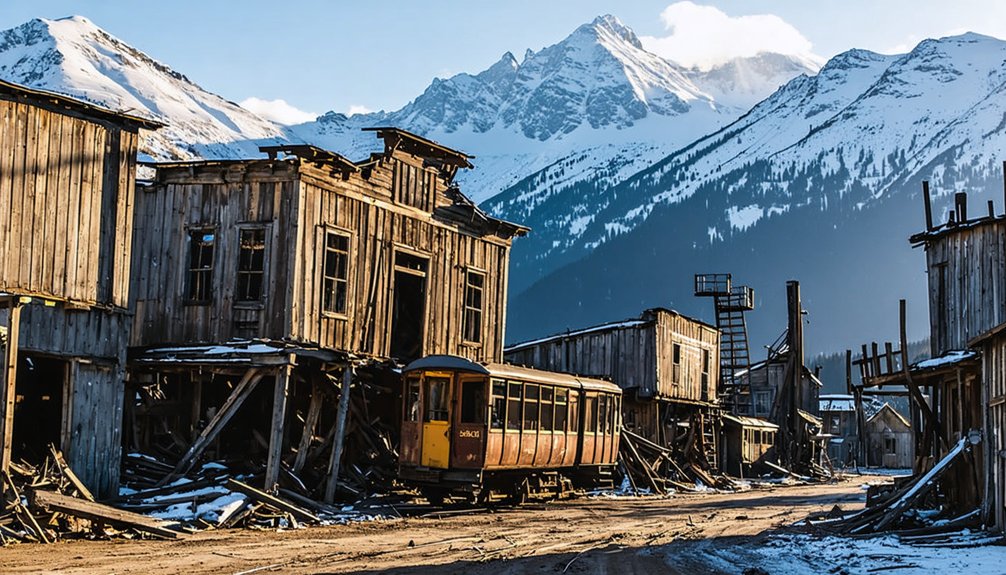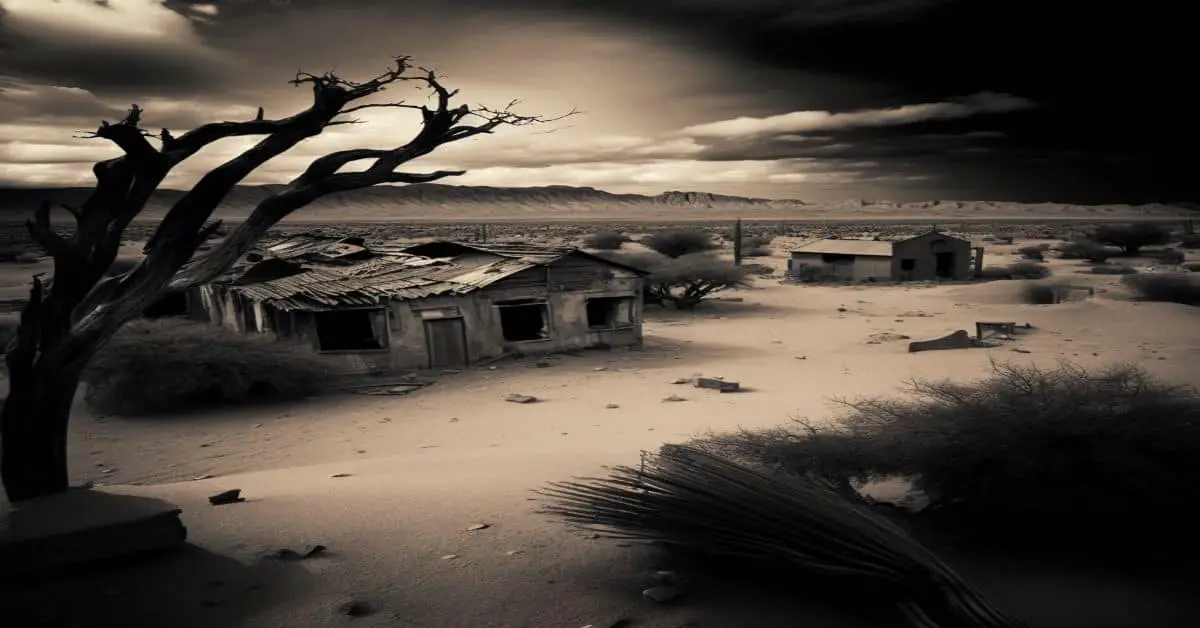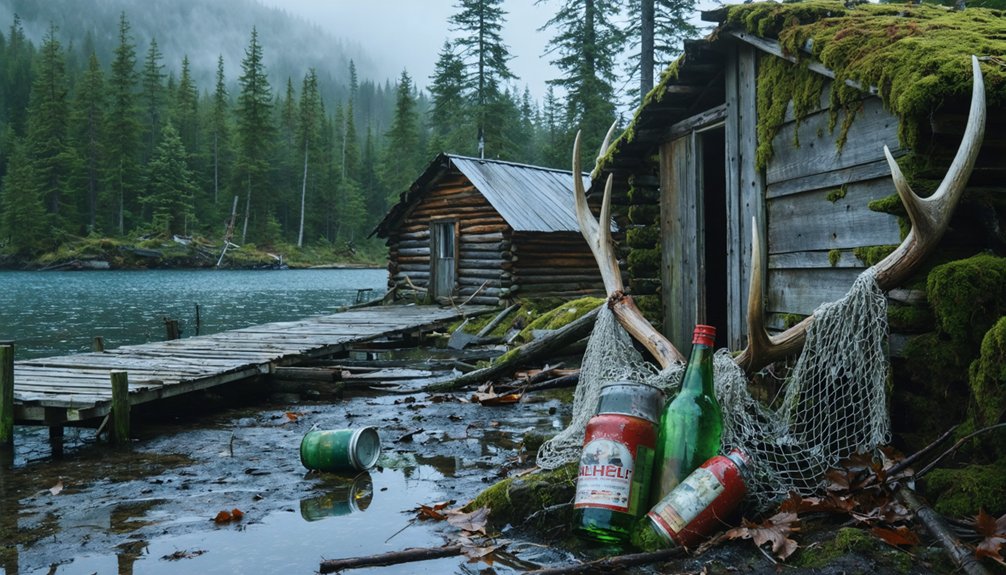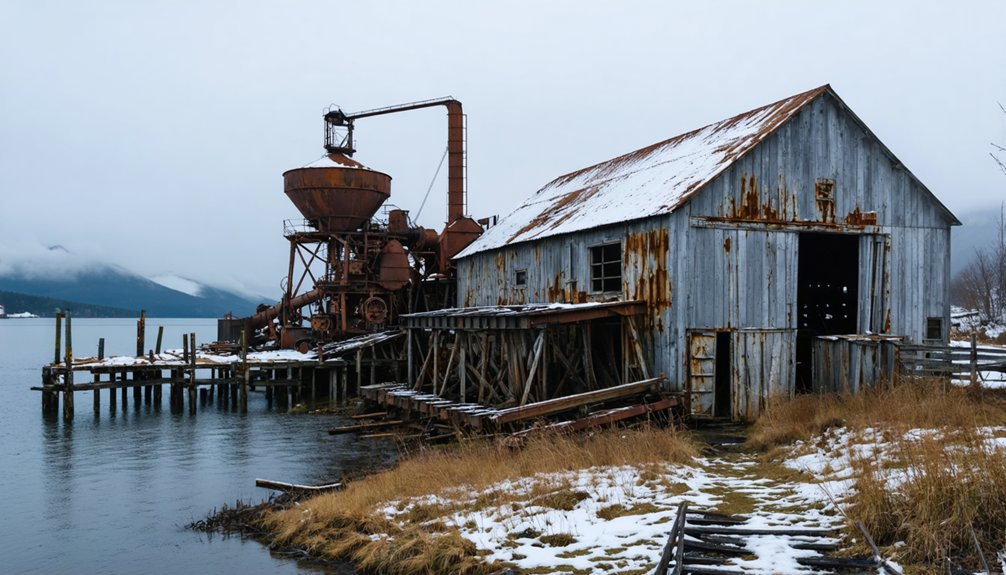You’ll discover Meehan as a once-thriving mining community established in the early 1900s, located 20 miles northeast of Fairbanks, Alaska. The town grew to 300 permanent residents by 1907, with its general store handling over $10 million in gold dust exchanges. Despite its prosperity, Meehan faced brutal winters, seismic activity, and environmental challenges. By the 1940s, these natural threats forced residents to abandon the town, leaving behind wooden structures that tell tales of frontier ambition.
Key Takeaways
- Meehan was an early 1900s Alaskan mining town located 20 miles northeast of Fairbanks that grew to 300 permanent residents by 1907.
- The town’s general store handled over $10 million in gold dust and served as a vital banking and community center.
- Seismic activity, harsh winters below -40°F, and unstable ground conditions eventually forced residents to abandon the town by the 1940s.
- Only one building remains standing today, with most structures having deteriorated or returned to nature over time.
- The ghost town’s legacy includes documented accounts of frontier life, preserved photographs, and integration into regional ghost town tourism.
The Meehan Brothers’ Gold Rush Vision
When the Meehan brothers established their mining community in the early 1900s, they envisioned more than just another transient gold rush settlement.
Located 20 miles northeast of Fairbanks, they strategically positioned their operation near river confluences perfect for placer mining, creating a crucial hub for the region’s gold trading activities.
You’ll find their most significant contribution to the Meehan legacy was their general store, which doubled as a sophisticated banking agency.
They installed a secured gold weighing room with a barred window and a large safe, serving as agents for Washington-Alaska Bank and First National Bank.
Through this setup, they handled over $10 million in gold dust, providing miners with essential currency exchange services and establishing Meehan as a trusted financial center in Alaska’s interior.
Similar to Nome’s peak in 1900, when tent cities stretched 30 miles along the beaches, the community grew rapidly to support 300 permanent residents by 1907, with thousands more scattered throughout the surrounding mining claims.
Life in a Booming Mining Town
The daily bustle of Meehan’s mining community revolved around its strategic economic hub, where miners would arrive with their gold dust for weighing and exchange.
You’d find two-story log homes scattered near the claims, where residents adapted to life without modern conveniences. The general store wasn’t just a supply depot – it handled over $10 million in gold transactions and served as the heart of community events. People from over 20 countries worked and lived together in the mining settlement.
Life wasn’t easy as you’d wrestle with harsh winters and demanding mining techniques. Your days would be spent sluicing, processing ore, and hauling supplies by pack animal or sled. Mule-driven carts transported valuable ore from the mines to market.
While the town lacked formal transportation infrastructure, you’d find a determined spirit among the miners and their families who called this remote Alaskan outpost home during its brief but prosperous heyday.
Social Scene and Entertainment
Despite its remote location, Meehan’s social scene thrived with four bustling saloons, two dance halls, and several roadhouses serving as entertainment hubs for the town’s 300 residents and roughly 1,000 people in the surrounding area.
The dance hall culture was especially vibrant, offering you a chance to shake off the day’s mining dust and connect with fellow settlers. The devastating 7.2 magnitude earthquake in 1912 brought an abrupt end to many of these social gathering spots. Like the isolation of Nome, Alaska, the town had limited transportation options for visitors.
You’d find entertainment options around every corner:
- Eagan and Griffin’s store, where you could swap saloon stories around the barrel stove
- Four lively saloons filled with music and conversation
- Two dance halls hosting regular community gatherings
- Several roadhouses welcoming both travelers and locals
- A restaurant that doubled as a social gathering spot
The social scene reflected the spirit of freedom and opportunity that drew people to this Alaskan frontier town.
Business and Commerce Along Fairbanks Creek
Starting in 1905, business activity along Fairbanks Creek centered around the Meehan brothers’ Discovery claim and their subsequent acquisition of most mining rights in the area.
The brothers established a thriving commercial hub anchored by a general store that supplied miners with essential provisions and tools. You’d find the store positioned strategically along Fairbanks Creek Road, about 20 miles north of Fairbanks city.
Trade routes connected Meehan’s merchants to Fairbanks, enabling the flow of mining supplies upstream and gold shipments downstream. Local commerce included blacksmithing services and other mining-related businesses. Like Judge James Wickersham’s influence in the region, political decisions often shaped the economic landscape of mining communities. The area proved incredibly lucrative, producing 380,115 fine ounces of gold between 1903 and 1920.
However, the store suffered earthquake damage in 1912, and over time, Fairbanks’ growing influence drew commerce away from Meehan. The altered landscape from mining operations, including changes to Alder Creek’s channel, eventually contributed to the town’s commercial decline.
Natural Challenges in the Alaskan Wilderness
You’d need incredible resilience to survive Meehan’s brutal winters, where pioneers faced temperatures plunging below -40°F while developing innovative shelter and food storage techniques.
Alaska’s seismic activity posed another constant threat, with earthquakes regularly damaging mining structures and requiring extensive repairs to maintain operations.
The surrounding wilderness harbored dangerous predators like grizzly bears and wolves, forcing residents to remain vigilant and develop strict safety protocols for their daily activities. The region’s harsh conditions were further complicated by melting permafrost, which destabilized buildings and infrastructure.
Harsh Winter Survival Tactics
When winter descends on Alaska’s remote wilderness, survival demands both physical fortitude and tactical knowledge. Your cold weather survival skills must focus on immediate shelter and heat generation to combat temperatures plunging below -40°F.
You’ll need to master these essential tactics:
- Build snow shelters or debris huts with proper ventilation to block wind
- Start and maintain fires using ferrous rods, protecting flames from harsh elements
- Layer clothing strategically while keeping your feet dry to prevent frostbite
- Melt snow for drinking water and maintain high-calorie food supplies
- Stay physically active to generate body heat while conserving energy
In these extreme conditions, your shelter becomes your lifeline. Construct it near fuel sources and guarantee proper insulation using natural materials. Finding an elevated, flat area with well-draining soil is crucial for establishing a safe sleeping location.
Earthquake Impacts and Recovery
Beyond the brutal winters, earthquakes posed another formidable threat to Meehan’s survival. You’d have witnessed the store’s vulnerability during seismic events, as violent shaking sent cans tumbling from shelves and pulled apart the stovepipe.
Nearby Mount Brooks suffered massive avalanches during the 1912 quake, demonstrating nature’s raw power. The settlement’s seismic resilience was severely tested as the ground shifted beneath wooden structures.
Recovery strategies proved challenging, especially with aftershocks continuing for weeks. The compound effects of infrastructure damage, soil instability, and landscape alterations made rebuilding increasingly difficult.
Like many Alaskan settlements facing similar natural threats, Meehan couldn’t sustain itself against these repeated blows. By the 1940s, the combination of seismic activity and other challenges had forced residents to abandon their mountain home.
Wildlife Encounters and Dangers
Living alongside Alaska’s untamed wildlife presented constant dangers for Meehan’s inhabitants, with grizzly bears posing the gravest threat. Your chances of wildlife encounters increased considerably during spring when bears emerged from hibernation, making wildlife safety protocols essential for survival.
Key dangers you’d face in Meehan included:
- Grizzly bears, responsible for 47 of 49 recorded attacks in Alaska (2000-2017)
- Territorial moose, known for their unpredictable aggression
- Defensive goshawks that would dive-bomb to protect their nests
- Marine wildlife threats during fishing activities
- Ground-nesting gulls and terns during breeding season
The region’s rugged terrain and remote location complicated matters further, as rescue efforts could take days.
You’d need to maintain constant vigilance, especially with bears drawn to improperly stored food and trash around settlements.
Daily Life and Community Spirit
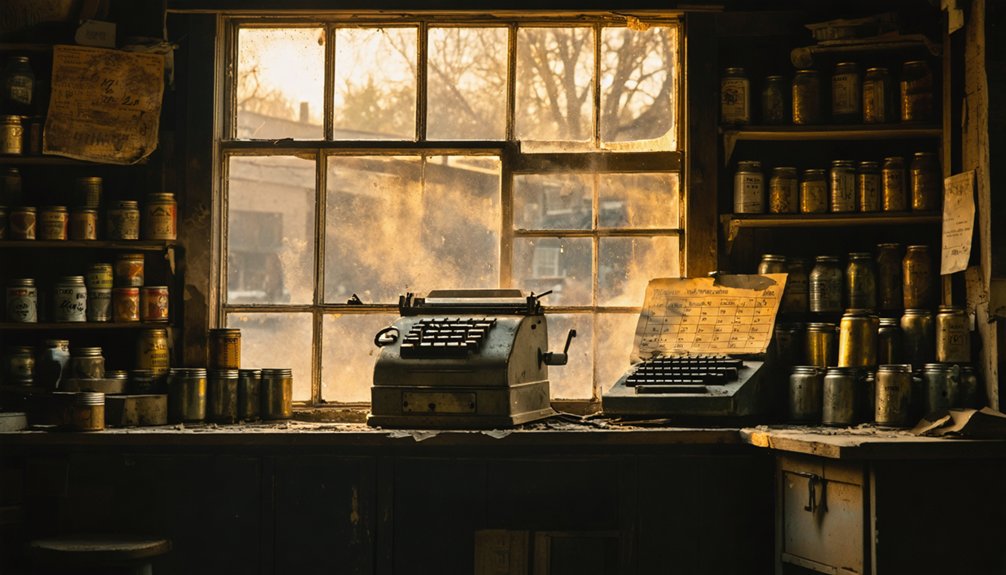
Despite harsh mining conditions, you’d find Meehan’s residents gathering regularly at Eagan and Griffin General Merchandise around the central barrel stove for conversation and camaraderie.
You could join neighbors at one of four saloons or two dance halls for evening entertainment and social events that helped offset the demanding work days.
The community’s spirit remained strong through organized celebrations and gatherings, even as miners faced the daily challenges of gold dredging operations along Fairbanks Creek.
Social Gatherings and Entertainment
As Meehan flourished in the early 1900s, its residents established a vibrant social scene centered around two dance halls, four saloons, and the bustling Eagan and Griffin General Merchandise store.
You’d find entertainment venues scattered throughout the town, serving a population of 300 residents and roughly 1,000 people in the surrounding area.
Community events brought together miners, merchants, and families at these popular gathering spots:
- Dance halls hosted nightly entertainment with music and dancing
- Saloons offered social drinking, card games, and storytelling
- The general store’s barrel stove drew folks for warmth and gossip
- A restaurant provided communal dining and celebrations
- The school doubled as a meeting place for various social functions
The harsh Alaskan environment made these social connections essential for maintaining community spirit and mutual support.
Daily Mining Town Routines
During the early 1900s, Meehan’s daily routines revolved around its two-shift mining schedule, with miners working either from 7 am to 6 pm or 7 pm to 5 am.
You’d find day shift workers managing hydraulic nozzles, washing thawed ground material through sluice boxes, while dragline operators removed large boulders to prevent clogs.
Between shifts, you’d see miners heading to the general store to trade gold dust for supplies or handle banking transactions.
Community routines centered on family life, with multi-generational households supporting the mining schedules.
You’d spot children playing together while their parents worked, and families gathering at the restaurant, dance halls, or schoolhouse.
The town’s infrastructure kept daily life running smoothly until the 1930s, when declining mining operations began changing these established patterns.
The Golden Years of Growth
While the broader Alaskan territory experienced multiple gold rushes in the late 19th century, Meehan emerged as a thriving mining community roughly 20 miles northeast of Fairbanks.
Amidst Alaska’s widespread gold fever, the mining settlement of Meehan carved out its own prosperous niche near Fairbanks.
The community’s resilience was evident in its rapid development as miners flocked to the area, establishing a robust economic hub centered around a crucial general store.
Key aspects of Meehan’s golden era included:
- A bustling store that processed over $10 million in gold dust transactions
- Banking services through partnerships with Washington-Alaska Bank and First National Bank
- Essential supplies and equipment distribution for local miners
- Community gathering spaces for business and social activities
- Gold weighing and currency exchange services that supported the mining economy
The town’s prosperity continued well into the early 1900s, showcasing the determined spirit of Alaska’s frontier mining communities.
Environmental Impact of Mining Operations
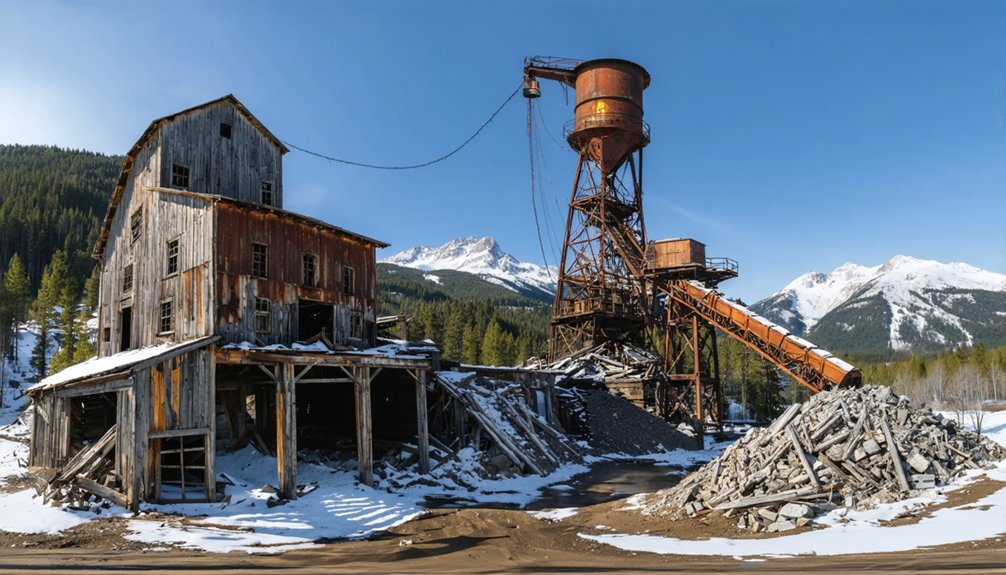
The environmental consequences of Meehan’s mining operations left a lasting negative impact on the region’s ecosystem.
You’ll find evidence of environmental degradation throughout the area, where acid mine drainage and heavy metal leaching contaminated local waterways. The disposal of waste rock and ore tailings processing created persistent water pollution issues that would plague the region for decades to come.
As mining activities intensified, you could witness the steady destruction of wildlife habitats and the disruption of sensitive ecosystems.
The contaminated water severely impacted local fish populations, including valuable salmon runs that had sustained the area’s economy.
Despite the economic benefits mining brought to Meehan, the regulatory system’s failure to prevent environmental violations resulted in long-term damage that continues to affect the land and water today.
The Town’s Gradual Decline
Mining’s environmental toll coincided with Meehan’s steady march toward abandonment.
You’ll find the town’s decline traced directly to the 1930s when mining activity sharply decreased, triggering widespread population migration and economic instability.
Here’s how Meehan’s story unfolded:
- Mining operations dwindled by 1937, leaving only a handful of residents.
- The Eagan family, who ran the general store and banking services, relocated to Fairbanks.
- The post office closed in 1942, marking a significant turning point.
- Key buildings deteriorated under Alaska’s harsh climate.
- The two-story Eagan home collapsed, leaving only the kitchen standing.
Modern-Day Remnants and Historical Legacy
Today you’ll find the historic Eagan cabin standing as the most prominent remnant of Meehan’s mining past, with sparse physical traces of the once-bustling town scattered across the landscape.
Most mining equipment and structures have succumbed to nature’s reclamation of the site, located about 20 miles northeast of Fairbanks.
The town’s cultural impact lives on through written accounts and oral histories, particularly through the memories of residents like Isabel Eagan Richards, who help preserve Meehan’s place in Alaska’s mining heritage.
Standing Structures Today
Limited records exist regarding Meehan’s remaining structures, though the site likely shares characteristics with other Alaskan ghost towns that feature deteriorating log cabins and wooden homes.
Like many abandoned settlements, Meehan’s standing structures have endured decades of harsh weather conditions and natural degradation.
If you’re planning to explore this ghost town, you might encounter:
- Weathered wooden buildings slowly returning to nature
- Remnants of log cabins that once housed early settlers
- Possible mining infrastructure scattered across the landscape
- Foundation outlines marking where community buildings stood
- Deteriorating structural elements that reflect the town’s frontier past
Modern preservation techniques, including digital documentation and virtual reality mapping, help maintain the historical legacy of sites like Meehan for future generations to study and explore.
Mining Equipment Left Behind
While standing structures offer glimpses into Meehan’s past, the mining equipment that once powered this gold-mining community has largely vanished.
You won’t find the picks, shovels, gold pans, or sluice boxes that miners once used to extract precious metals from the earth. The evolution of mining techniques at Meehan remained relatively basic, with no evidence of larger industrial equipment like stamp mills or tramways that characterized bigger operations of the era.
Unlike more substantial mining camps near Fairbanks that preserved their mechanical heritage, Meehan’s equipment met common fates: salvaged for other uses, destroyed by Alaska’s harsh climate, or simply hauled away when operations ceased.
Even the store’s gold scales and safe disappeared when the building was demolished after 1942, leaving only scattered fragments of the town’s mining legacy.
Cultural Impact Remains
Despite Meehan’s physical deterioration over time, its cultural legacy endures through various channels of preservation and memory.
You’ll find the town’s impact preserved through community memory and historical documentation, with one remaining building serving as a tangible link to its mining past.
The town’s cultural preservation efforts include:
- Archival photographs and primary source documents
- Stories from pioneer families like the Eagans
- Protection of nearby Native spiritual sites
- Academic research and historical society records
- Integration into regional ghost town tourism narratives
While Meehan’s physical remnants can’t match those of Kennecott or McCarthy, its social heritage lives on through documented accounts of the bustling community life centered around the general store, dance halls, and school that once served hundreds of residents and miners in the early 1900s.
Frequently Asked Questions
What Happened to the Original Mining Equipment and Machinery?
You’ll find the equipment was sold off or scrapped when mining techniques changed. Some machines became ghost town remnants, while others were preserved in private collections or the Daniel F. Eagan Machine Shop.
Did Any Descendants of Meehan’s Original Residents Still Live in Alaska?
While descendant stories suggest families like the Eagans likely continued living in Alaska, there’s no direct proof. You’ll find scattered family ties hinting at their presence, but it’s not officially documented.
Were There Any Documented Criminal Incidents or Law Enforcement Presence?
You won’t find detailed crime reports or clear documentation of law enforcement presence in Meehan’s history. The town’s remote location and limited historical records don’t reveal specific incidents or police activities.
What Types of Artifacts Have Been Recovered From the Town Site?
Despite 100+ years of local history, you won’t find documented evidence of artificial artifacts or mining relics recovered from this site – no official excavations or artifact collections have been recorded.
Did Native Alaskan Communities Interact With the Meehan Settlement?
While you’d expect cultural exchange and trade relationships, there’s limited direct evidence of Native Alaskan interactions with Meehan, though indigenous communities were known to inhabit and use the surrounding area.
References
- https://www.uaf.edu/news/one-big-earthquake-two-alaska-ghost-towns.php
- https://www.sketchesofalaska.com/2012/01/meandering-mining-camp-where-is-meehan.html
- https://www.thealaskalife.com/blogs/news/alaska-ghost-towns-youve-probably-never-heard-of
- https://www.youtube.com/watch?v=Cz0IGc2Uy0E
- https://motorcyclemojo.com/2015/09/alaska-ghost-towns/
- https://www.youtube.com/watch?v=NsI8bIhJ2pA
- https://www.gi.alaska.edu/alaska-science-forum/ghost-towns-scattered-across-alaska-map
- https://en.wikipedia.org/wiki/List_of_ghost_towns_in_Alaska
- https://www.co.fairbanks.ak.us/DocumentCenter/View/902/Historic-Preservation-Plan-PDF
- https://www.nps.gov/articles/alaska-goldrush-national-historic-landmarks.htm
